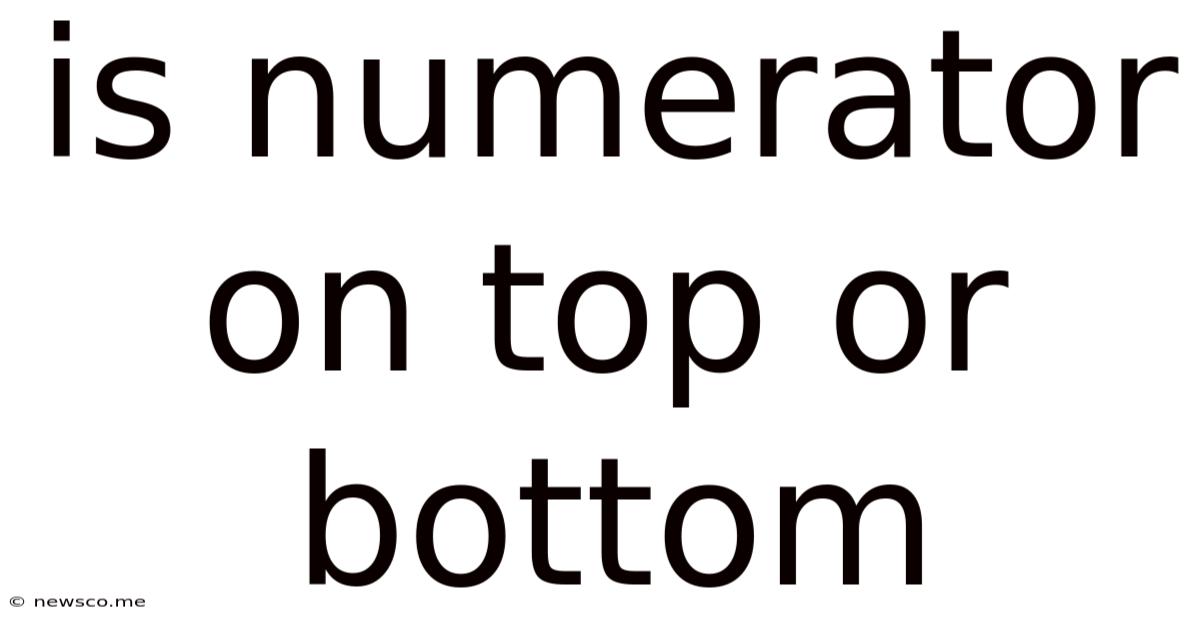Is Numerator On Top Or Bottom
News Co
Apr 14, 2025 · 4 min read

Table of Contents
Is Numerator on Top or Bottom? A Comprehensive Guide to Fractions
Understanding fractions is fundamental to mathematics and numerous real-world applications. A core component of grasping fractions lies in knowing the position of the numerator and denominator. This comprehensive guide will definitively answer the question: Is the numerator on top or bottom? We'll explore this concept in detail, examining its significance, practical applications, and common misconceptions.
Understanding the Parts of a Fraction
A fraction represents a part of a whole. It's composed of two key parts:
-
Numerator: This is the top number in a fraction. It indicates how many parts of the whole are being considered. Think of it as the "number of parts you have."
-
Denominator: This is the bottom number in a fraction. It indicates the total number of equal parts the whole is divided into. Consider it the "total number of parts."
Therefore, the simple answer is: Yes, the numerator is on top. Let's illustrate this with an example:
3/4
In this fraction:
- 3 is the numerator (the number of parts we have).
- 4 is the denominator (the total number of equal parts).
This means we have 3 out of 4 equal parts of a whole.
Visualizing Fractions: A Clearer Understanding
Visual aids significantly improve comprehension. Imagine a pizza cut into four equal slices. If you eat three slices, you've consumed 3/4 of the pizza.
- Numerator (3): Represents the three slices you ate.
- Denominator (4): Represents the four total slices the pizza was divided into.
Why the Position Matters: The Importance of Numerator and Denominator Placement
The placement of the numerator and denominator isn't arbitrary; it's crucial for representing the fractional value correctly. Switching their positions dramatically alters the meaning:
If we reverse the fraction 3/4 to 4/3, the meaning completely changes. 4/3 represents more than one whole (it's an improper fraction), indicating we have 4 slices when there are only 3 slices in a whole pizza. This highlights the critical role of correct placement.
Common Misconceptions and How to Avoid Them
While the concept seems straightforward, certain misconceptions can arise:
1. Confusing Numerator and Denominator
The most common mistake is interchanging the numerator and denominator. Remember the simple mnemonic: "Numerator on top, denominator down below." Consistent practice and visualization exercises are key to preventing this error.
2. Incorrect Interpretation of Improper Fractions
Improper fractions (where the numerator is larger than or equal to the denominator) can be confusing. They represent a value greater than or equal to one. For instance, 7/4 signifies more than one whole – one whole and three-quarters. Understanding this helps in accurately interpreting fractional values.
3. Difficulty in Simplifying Fractions
Simplifying fractions (reducing them to their lowest terms) involves dividing both the numerator and denominator by their greatest common divisor. This process simplifies the representation without changing the value of the fraction. Practice with various examples helps master this essential skill.
Advanced Concepts and Applications
While the basic understanding of numerator and denominator placement is crucial, let's explore some more advanced applications:
1. Mixed Numbers
Mixed numbers combine a whole number and a proper fraction (numerator < denominator). For example, 1 ¾ represents one whole and three-quarters. Converting between mixed numbers and improper fractions is a vital skill.
2. Decimal Representation
Fractions can be expressed as decimals. To convert a fraction to a decimal, divide the numerator by the denominator. This skill connects fractions and decimals, strengthening overall number sense.
3. Ratio and Proportion
Fractions are fundamental to understanding ratios and proportions. A ratio compares two quantities, and proportions demonstrate the equality of two ratios. Applications range from scaling recipes to calculating speeds and distances.
4. Algebraic Expressions
Fractions appear frequently in algebraic expressions and equations. Understanding the numerator and denominator's roles is crucial for simplifying, solving, and manipulating algebraic expressions.
Real-World Applications: Fractions in Everyday Life
Fractions are far from abstract mathematical concepts; they are integral to our daily lives:
-
Cooking and Baking: Recipes often involve fractional measurements (½ cup of sugar, ⅓ cup of flour). Accurately understanding fractions ensures successful baking and cooking outcomes.
-
Construction and Engineering: Precise measurements are essential in construction. Fractions ensure accurate building and engineering feats.
-
Finance and Budgeting: Managing personal finances involves fractional calculations (calculating discounts, interest rates, and loan payments).
-
Time Management: We often express time in fractions (½ hour, ¼ hour).
-
Measurement: Many measuring tools use fractions (rulers, tape measures).
Conclusion: Mastering Fractions for Success
Understanding the fundamental placement of the numerator (on top) and the denominator (on the bottom) is the cornerstone of fraction comprehension. While seemingly simple, this understanding paves the way for mastering more complex fractional concepts and utilizing this essential mathematical skill in diverse real-world applications. Continuous practice, visualization, and exploring different fractional representations—such as decimals and mixed numbers—will solidify your understanding and pave the way for mathematical success. The ability to work confidently with fractions will enhance your capabilities across numerous fields, proving invaluable in both academic and professional settings. Remember the simple rule: Numerator on top, denominator on the bottom, and you'll be well on your way to mastering the world of fractions.
Latest Posts
Related Post
Thank you for visiting our website which covers about Is Numerator On Top Or Bottom . We hope the information provided has been useful to you. Feel free to contact us if you have any questions or need further assistance. See you next time and don't miss to bookmark.